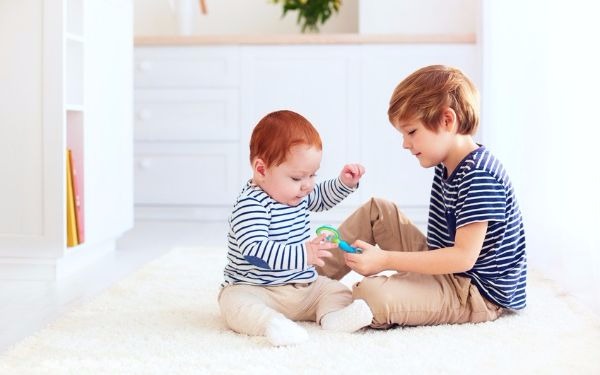
by John Simmonds
Our brothers and sisters are likely to be some of the most long-lasting relationships each of us has.
That is not to underestimate the complexity of those relationships. After all, sibling rivalry is a reality in many of those relationships, although hopefully set alongside the love, support, sharing and curiosity that enriches our lives through childhood, adolescence and adulthood.
For many children, sibling relationships will also include children from other relationships where the parents have separated, and a new relationship for the adults will result in a new set of imposed relationships for the children. Again, what the quality and meaning of those relationships will have for the children involved will be complex.
While this is all very familiar, the issues for children who come into care is far more complex. This can result from the increased complexity and instability of adult relationships, the numbers of partners that any particular parent may have and the children that result from those partnerships.
Parenting role
If children come into care, will they be placed together or will the constraints in the foster care system result in them being placed separately?
Over time, might they be re-united? Some children will have adjusted to taking on the parenting role to their younger siblings when their parents don’t or can’t. How do they adjust when the foster carer is able to do this for them?
What then happens in the longer term as the local authority and the courts come to a decision and make a long-term plan for the children? Should the children be placed together or apart? This question revolves around the needs of each child and then the needs of the children as a group.
Together or apart – that is the question that perplexes many practitioners. How do I find a placement where the adopters or fosters carers have the practical resources such as housing, emotional strength, resilience and commitment over time and the insight to fully understand what taking two, three of four siblings might mean?
What does this mean from the child/ren’s point of view? Are realistic support packages available to prospective adopters considering siblings to give them the reassurance and confidence that the support we know they will need?
Urgent
It is an enormous and challenging question that frequently defies straightforward answers. But answers are needed and urgently.
There are many sibling placements that are successfully made – in adoption and foster care. But there are many children who are not placed together. Some for very good reasons and others just because a placement cannot be found.
Some sibling relationships continue through the efforts of the adopters or foster carers and some relationships fall away under the challenge of other pressing issues. This may result in significant feelings of loss, betrayal, anger or hopelessness. It can be a tragedy of enormous significance.
That is the challenge and focus of this year’s National Adoption Week (October 16 – 20). It is to be hoped that the needs of children, and the relationships they have with or might have with their siblings, are prioritised as they must be.
John Simmonds is director of policy, research and development at CoramBAAF.


 Assistive technology and dementia: practice tips
Assistive technology and dementia: practice tips  A trauma-informed approach to social work: practice tips
A trauma-informed approach to social work: practice tips 




 Find out how to develop your emotional resilience with our free downloadable guide
Find out how to develop your emotional resilience with our free downloadable guide  Develop your social work career with Community Care’s Careers and Training Guide
Develop your social work career with Community Care’s Careers and Training Guide  ‘Dear Sajid Javid: please end the inappropriate detention of autistic people and those with learning disabilities’
‘Dear Sajid Javid: please end the inappropriate detention of autistic people and those with learning disabilities’ Ofsted calls for power to scrutinise children’s home groups
Ofsted calls for power to scrutinise children’s home groups Seven in eight commissioners paying below ‘minimum rate for home care’
Seven in eight commissioners paying below ‘minimum rate for home care’
 Facebook
Facebook X
X LinkedIn
LinkedIn Instagram
Instagram
Very pleased to see this important issue being prioritised and the focus of National Adoption Week. I am currently undertaking research funded by the Nuffield Foundation into the role that law plays in helping or hindering contact between siblings who are separated:
http://www.nuffieldfoundation.org/siblings-contact-and-law-overlooked-relationship
I look forward to sharing the findings of the research next year
They use emotional harm against parent to remove children wrongfully. They cause emotional harm to children and there parents by splitting up siblings if they can’t be adopted together as adoption and fostering targets are more important than helping family’s stay together. They obtain section 20 reports just so they can build cases against loving parents. They make parents do psychological assessments to then have more ammo for removal. Then parents fond out that the assessments are wrong and can’t do nothing about it.
Not the same situation but similar in the fact that my adopted daughter and her birth sibling were placed separately but at different times, one after the other as they were born. I feel strongly that it is up to the adoptive parents/foster cadets I maintain that contact as often as possible no matter how hard it is to maintain. We owe it to these children who didn’t have a say in this. A relationship- no matter how ‘different’ from other sibling relationships is better than not knowing, wondering, speculating, fantasising and a potential feeling of loss that could follow should a relationship not be maintained. I am not necessarily an advocate of keeping them together as this can sometimes cause issues with finding families or breakdowns, but if they do need to be separated it should be compulsory to see each other. It’s all a matter of identity.
I couldn’t agree more, Kelly!